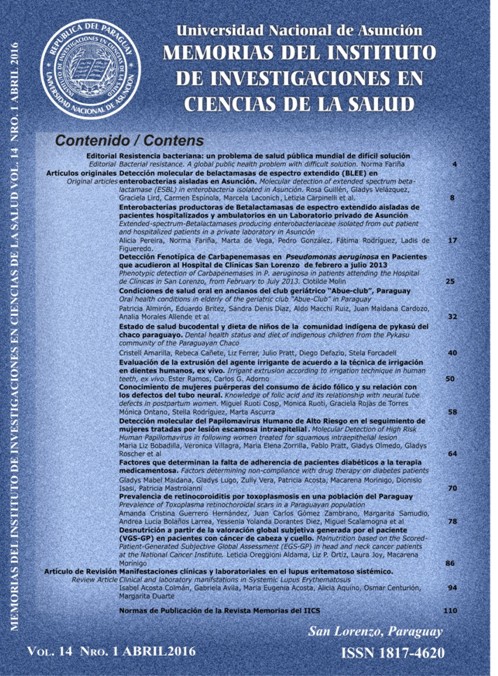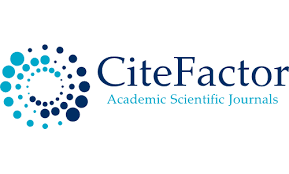Evaluación de la extrusión del agente irrigante de acuerdo a la técnica de irrigación en dientes humanos, ex vivo
Palabras clave:
Irrigación por presión negativa, Irrigación por jeringa, extrusión, endodoncia, conductos radicularesResumen
El agente irrigante debería alcanzar la totalidad del conducto radicular, inclusive las zonas más apicales, para mejor la limpieza y desinfección. Sin embargo existe el riesgo de la extrusión del mismo a los tejidos periapicales. El presente estudio con diseño experimental tuvo el objetivo de evaluar la extrusión apical del agente irrigante endodóntico de acuerdo a la técnica de irrigación durante la irrigación final en dientes naturales, ex vivo. Se utilizaron 46 dientes anterosuperiores naturales extraídos con conducto único y las raíces se sumergieron en una gelatina conductora incolora. Una aguja de irrigación/aspiración fue colocada a 2 mm de la longitud de trabajo y se irrigaron los conductos con una solución de contraste a 4 ml/min durante 60 s. En 18 dientes se utilizó la técnica de irrigación por jeringa y en los 18 restantes se utilizó la técnica por presión negativa. Los controles positivos y negativos estaban compuestos por 5 dientes cada uno. Se evaluaron presencia y área de extrusión. La prueba Chi2 encontró una asociación estadísticamente significativa (p <0,001) entre la presencia de extrusión y la técnica de irrigación. El área mediana de extrusión provocada por irrigación por jeringa (0,645 mm2) fue estadísticamente mayor a la provocada por la irrigación por presión negativa (0 mm2) (U Mann Whitney, p <0,001). Se concluyó que la irrigación por presión negativa produce menos extrusión de la solución irrigante, no sólo en frecuencia sino también en área de extrusión comparado con la irrigación por jeringa.
Descargas
Citas
Sundqvist G, Figdor D, Persson S, Sjögren U. Microbiologic analysis of teeth with failed endodontic treatment and the outcome of conservative re-treatment. Oral Surg Oral Med Oral Pathol Oral Radiol Endod. 1998 Jan;85(1):86–93.
Peters OA, Schönenberger K, Laib A. Effects of four Ni-Ti preparation techniques on root canal geometry assessed by micro computed tomography. Int Endod J. 2001;34(3):221–30.
Clegg MS, Vertucci FJ, Walker C, Belanger M, Britto LR. The effect of exposure to irrigant solutions on apical dentin biofilms in vitro. J Endod. 2006;32(5):434–7.
Haapasalo M, Shen Y, Qian W, Gao Y. Irrigation in endodontics. Dent Clin North Am. 2010;54(2):291–312.
Khademi A, Yazdizadeh M, Feizianfard M. Determination of the minimum instrumentation size for penetration of irrigants to the apical third of root canal systems. J Endod. 2006;32(5):417–20.
Behrents KT, Speer ML, Noujeim M. Sodium hypochlorite accident with evaluation by cone beam computed tomography. Int Endod J. 2012;45(5):492–8.
Zhu W-C, Gyamfi J, Niu L-N, Schoeffel GJ, Liu S-Y, Santarcangelo F, et al. Anatomy of sodium hypochlorite accidents involving facial ecchymosis-A review. J Dent. 2013;41(11):935–48.
Shin S-J, Kim H-K, Jung I-Y, Lee C-Y, Lee S-J, Kim E. Comparison of the cleaning efficacy of a new apical negative pressure irrigating system with conventional irrigation needles in the root canals. Oral Surg Oral Med Oral Pathol Oral Radiol Endod. 2010;109(3):479–84.
Miller TA, Baumgartner JC. Comparison of the antimicrobial efficacy of irrigation using the EndoVac to endodontic needle delivery. J Endod. 2010;36(3):509–11.
Gondim E Jr, Setzer FC, Dos Carmo CB, Kim S. Postoperative pain after the application of two different irrigation devices in a prospective randomized clinical trial. J Endod. 2010;36(8):1295–301.
Fukumoto Y, Kikuchi I, Yoshioka T, Kobayashi C, Suda H. An ex vivo evaluation of a new root canal irrigation technique with intracanal aspiration. Int Endod J. 2006;39(2):93–9.
Mitchell RP, Baumgartner JC, Sedgley CM. Apical extrusion of sodium hypochlorite using different root canal irrigation systems. J Endod. 2011;37(12):1677–81.
İriboz E, Bayraktar K, Türkaydın D, Tarçın B. Comparison of apical extrusion of sodium hypochlorite using 4 different root canal irrigation techniques. J Endod. 2015;41(3):380–4.
Brunson M, Heilborn C, Johnson DJ, Cohenca N. Effect of apical preparation size and preparation taper on irrigant volume delivered by using negative pressure irrigation system. J Endod. 2010;36(4):721–4.
Adorno CG, Fretes VR, Ortiz CP, Mereles R, Sosa V, Yubero MF, et al. Comparison of two negative pressure systems and syringe irrigation for root canal irrigation: an ex vivo study. Int Endod J. 2016:49(2):174-83.
Siu C, Baumgartner JC. Comparison of the debridement efficacy of the EndoVac irrigation system and conventional needle root canal irrigation in vivo. J Endod. 2010;36(11):1782–5.
R Core Team. R: A Language and Environment for Statistical Computing [Internet]. Vienna, Austria: R Foundation for Statistical Computing; 2015. Available from: http://www.R-project.org/
Desai P, Himel V. Comparative safety of various intracanal irrigation systems. J Endod. 2009;35(4):545–9.
Bukiet F, Soler T, Guivarch M, Camps J, Tassery H, Cuisinier F, et al. Factors affecting the viscosity of sodium hypochlorite and their effect on irrigant flow. Int Endod J. 2013;46(10):954–61.
van der Sluis LWM, Vogels MPJM, Verhaagen B, Macedo R, Wesselink PR. Study on the influence of refreshment/activation cycles and irrigants on mechanical cleaning efficiency during ultrasonic activation of the irrigant. J Endod. 2010;36(4):737–40.
Verhaagen B, Boutsioukis C, Heijnen GL, van der Sluis LWM, Versluis M. Role of the confinement of a root canal on jet impingement during endodontic irrigation. Exp Fluids. 2012;53(6):1841–53.
Shen Y, Gao Y, Qian W, Ruse ND, Zhou X, Wu H, et al. Three-dimensional numeric simulation of root canal irrigant flow with
different irrigation needles. J Endod. 2010;36(5):884–9.
Boutsioukis C, Verhaagen B, Versluis M, Kastrinakis E, Wesselink PR, van der Sluis LWM. Evaluation of irrigant flow in the root canal using different needle types by an unsteady computational fluid dynamics model. J Endod. 2010;36(5):875–9.
Boutsioukis C, Psimma Z, Kastrinakis E. The effect of flow rate and agitation technique on irrigant extrusion ex vivo. Int Endod J. 2014;47(5):487–96.
Boutsioukis C, Lambrianidis T, Kastrinakis E, Bekiaroglou P. Measurement of pressure and flow rates during irrigation of a root canal ex vivo with three endodontic needles. Int Endod J. 2007;40(7):504–13.
Park E, Shen Y, Khakpour M, Haapasalo M. Apical pressure and extent of irrigant flow beyond the needle tip during positive-pressure irrigation in an in vitro root canal model. J Endod. 2013;39(4):511–5.
Boutsioukis C, Lambrianidis T, Kastrinakis E. Irrigant flow within a prepared root canal using various flow rates: a Computational Fluid Dynamics study. Int Endod J. 2009;42(2):144–55.
Psimma Z, Boutsioukis C, Vasiliadis L, Kastrinakis E. A new method for real-time quantification of irrigant extrusion during root canal irrigation ex vivo. Int Endod J. 2013;46(7):619–31.
Hülsmann M, Hahn W. Complications during root canal irrigation-literature review and case reports. Int Endod J. 2000;33(3):186–93.
Kleier DJ, Averbach RE, Mehdipour O. The sodium hypochlorite accident: experience of diplomates of the American Board of Endodontics. J Endod. 2008;34(11):1346–50.














